Exploring Thunderbolt 3 eGFX Performance, Feat. PowerColor's Gaming Station & Radeon RX Vega 56 Nano
by Ganesh T S on February 13, 2019 10:00 AM EST- Posted in
- GPUs
- AMD
- Radeon
- PowerColor
- Thunderbolt 3
- eGFX
- RX Vega 56 Nano Edition
Workstation Workloads - SPECviewperf 13
The SPECviewperf benchmark from SPEC provides an idea of the capabilities of the GPU in a workstation from the perspective of different CAD, content creation, and visual data analysis tools. It makes more sense to process these benchmarks on workstations with professional GPUs, but, consumer GPUs are often the choice for machines that need to handle both gaming and professional workloads.
SPECviewperf 13 includes nine different workloads representative of graphics content and behavior of actual applications. They make use of the OpenGL 4.0 and DirectX 12 APIs under Windows. SPECviewperf 13's workloads (termed viewsets) can officially be run only at two desktop resolutions (1920 x 1080, and 3840 x 2160), and need the dsplay scaling to be set to 100% (DPI of 96). The available viewsets are listed below.
- 3ds Max (3dsmax-06)
- CATIA (catia-05)
- Creo (creo-02)
- Energy (energy-02)
- Maya (maya-05)
- Medical (medical-02)
- Showcase (showcase-02)
- Siemens NX (snx-03)
- Solidworks (sw-04)
The 3ds Max and Showcase viewsets are available only when processing at 1920 x 1080. The rest are available at both resolutions.
We processed SPECviewperf 13 at both resolutions on all the systems. The benchmark measures the frame rate at which the GPU renders the scenes in a viewset. Each viewset is composed of different scenes and rendering modes, and the composite score for the viewset is a weighted geometric mean of the FPS measured for the different scenes. In this section, we take a look at how its composite scores stack up against other systems targeting this market segment.
3ds Max (3dsmax-06)
The 3dsmax-06 viewset comprises of 11 different scenes. They have been created from traces of the graphics workload generated by Autodesk 3ds Max 2016 using the default Nitrous DX11 driver. Additional details are available here.
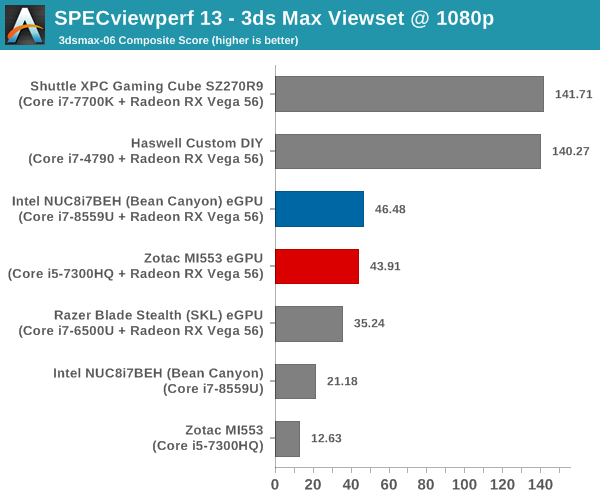
The host - GPU bandwidth seems to have a significant impact in this workload, as the x16 configuration outperforms the x4 eGPU performance by more than a factor of 3.
CATIA (catia-05)
The catia-05 viewset comprises of 14 different tests created from traces of the graphics workload generated by the CATIA V6 R2012 application from Dassault Systemes. Additional details are available here.
| SPECviewperf 13: CATIA Viewset Composite Scores | |||
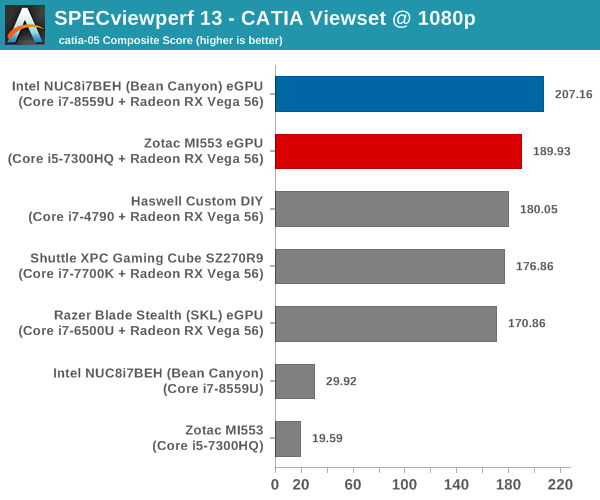
Unlike 3ds Max, CATIA doesn't seem to be influenced by the host - GPU bandwidth. The CPU power in terms of burst frequencies and number of threads appear to have more of an impact.
Creo (creo-02)
The creo-02 viewset comprises of 16 different tests created from traces of the graphics workload generated by the Creo 3 and Creo 4 applications from PTC. Additional details are available here.
| SPECviewperf 13: Creo Viewset Composite Scores | |||
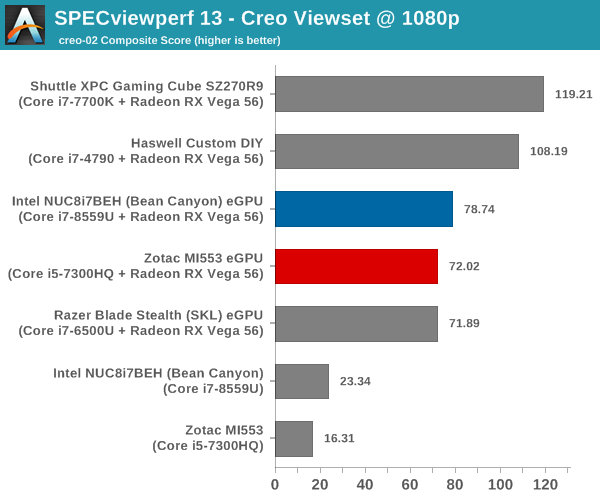
Creo shows sensitivity to the host - GPU bandwidth, just like 3ds Max.
Energy (energy-02)
The energy-02 viewset comprises of 6 different tests based on techniques used by the OpendTect seismic visualization application. Additional details are available here.
| SPECviewperf 13: Energy Viewset Composite Scores | |||

The energy viewset doesn't show much of a performance difference across the different systems, showing that the workload is likely fully limited by GPU capabilities.
Maya (maya-05)
The maya-05 viewset comprises of 10 different tests based on traces of the graphics workload generated by Autodesk Maya 2017. Additional details are available here.
| SPECviewperf 13: Maya Viewset Composite Scores | |||

Like 3ds Max, Maya is sensitive to the host - GPU bandwidth, but, we don't see as much of a difference in the relative numbers with this workload.
Medical (medical-02)
The medical-02 viewset comprises of 8 different tests derived from 4 distinct datasets. Each test uses the ImageVis3D volume visualization program's Tuvok rendering core for 2D projections of 3D volumetric grids. Additional details are available here.
| SPECviewperf 13: Medical Viewset Composite Scores | |||
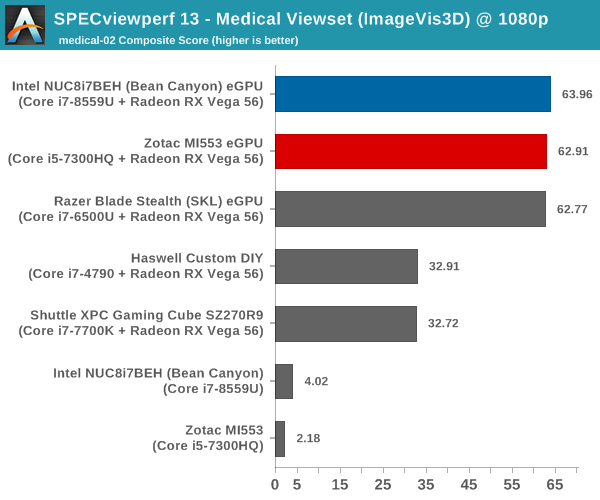
For some unexplained reason, the medical viewset seems to perform better with the eGPU configurations.
Showcase (showcase-02)
The showcase-02 viewset comprises of 4 tests created from traces of the Autodesk Showcase 2013 application rendering a racecar model with 8 million vertices using different modes. Additional details are available here.
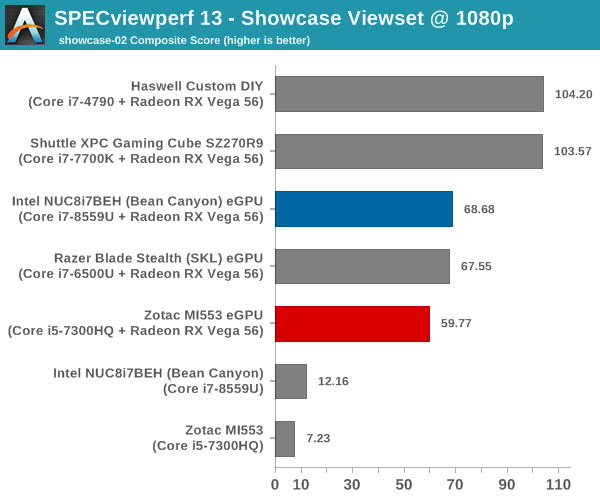
This workload is again sensitive to the host - GPU bandwidth - not as much as 3ds Max, but, more than Maya.
Siemens NX (snx-03)
The snx-03 viewset comprises of 10 tests created with traces from the graphics workload generated by the NX 8.0 application from Siemens PLM. Additional details are available here.
| SPECviewperf 13: Siemens NX Viewset Composite Scores | |||

snx-03 shows almost a 5x performance difference in favor of the internal GPU solutions.
Solidworks (sw-04)
The sw-04 viewset comprises of 11 tests created from traces of Dassault Systemes’ SolidWorks 2013 SP1 application. Additional details are available here.
| SPECviewperf 13: Solidworks Viewset Composite Scores | |||

Solidworks appears to be CPU-limited, with the Bean Canyon eGPU solution performing almost as well as the two internal GPU solutions.










25 Comments
View All Comments
piroroadkill - Thursday, February 14, 2019 - link
I have no idea how manufacturers continue to make external GPU boxes larger than the Dan A4-SFX, which can hold an entire PC.umano - Sunday, February 17, 2019 - link
I get what you mean, I'd love to build a ghost S1 to acquire video on set and then going back home, plug the eGFX and do the editing/color grade on a proper machine with 2 gpuGNUminex_l_cowsay - Wednesday, February 13, 2019 - link
Once I saw that the testing was the same GPU with radically different processors, in terms of TDP, it was pretty obvious how the bench marking would turn out. I'd be far more interested in seeing something like different GPUs say RX 560, RX 580, GTX1080ti, the same system connected through internal pcie and then again with eGPU. I don't really care whether such configurations are realistic. I'm just really curious if there are factors like latency and bandwidth involved and how that scales with different levels of GPU performance.BushLin - Wednesday, February 27, 2019 - link
I would have been happy with just one system tested with the same GPU internally 16x against using the eGPU at 4x.eastcoast_pete - Wednesday, February 13, 2019 - link
Interesting review, but I missed two points I'd like to know.1. Would have loved to see how this enclosure works with any recent, decent NVIDIA card, so a 970 or better/newer. You didn't have one around for that? Doesn't have to be the whole test suite, just some highlights and whether it was any more or less painful to get up and running.
2. Would have loved to see an internal vs. external dGPU apples-to-apples comparison using the exactly same system with the same CPU, mobo, memory etc. so a true card outside (eGPU) vs. the card(s) inside the PCI-e 8x or 16x slot. Basically, how big is the loss of performance over TB3/4 lanes, all other things being equal? If possible, with the 56 Nano and any NVIDIA card you have lying around. That would have given us a quick heads-up on what to expect.
sorten - Thursday, February 14, 2019 - link
Not sure I understand the request for an NVidia card. Have you experienced problems with NVidia cards inside eGPU enclosures? If you're just interested in bandwidth issues, the Vega 56 is going to show that problem much earlier than the 970 given it's 2x performance advantage.eastcoast_pete - Thursday, February 14, 2019 - link
No, I haven't. But, with eGPUs still being new-ish, just knowing that this enclosure plays nice with at least one NVIDIA card also would be good to know. I agree that the 970 has lower bandwidth demand than the Vega 56. I mentioned it only as a minimum if tested. What would be more interesting would be a 2070 or better, but not many reviewers have a spare 2070 or 2080 sitting around.dave_the_nerd - Wednesday, February 13, 2019 - link
I really wish more of these eGPU enclosures would come with an internal SATA bay or two and an HDMI port. I want a gaming dock, dagnammit, and I don't need to be carting around my Steam library when I'm out and about.SirKronan - Thursday, February 14, 2019 - link
I highly recommend the Gigabyte Gaming Box series. They can be had in 1080, 1070, and RX 580 (8GB) varieties. They are small, have 3.0 ports, display ports, and I believe an HDMI port as well. I am extremely happy with mine.Do NOT buy a used one on Amazon, regardless of the condition! Only get a new one. I don't think the testing validation is very thorough at all. They plug it in, it lights up, and I imaging they call it good or "like new" when that happens, and resell it. I am 0 for 2 on used eGPUs, but my new RX 580 Gaming Box is excellent. I'm surprised Anand didn't mention them in this article. It addresses some of the minor gripes of most eGPUs - especially their large sizes.
Fiebre - Wednesday, February 13, 2019 - link
I'd be really interested to see results with more modern GPUs as well.